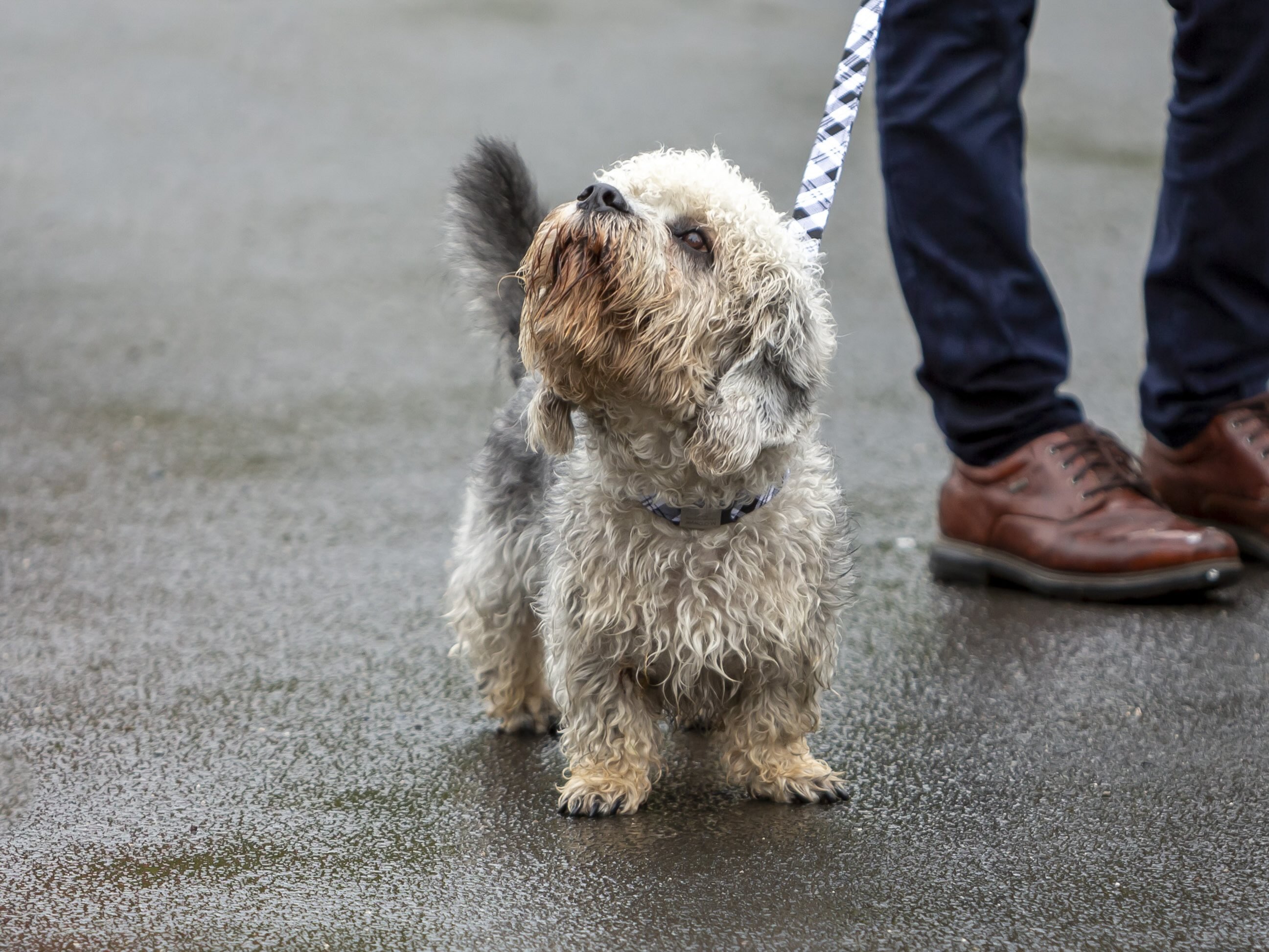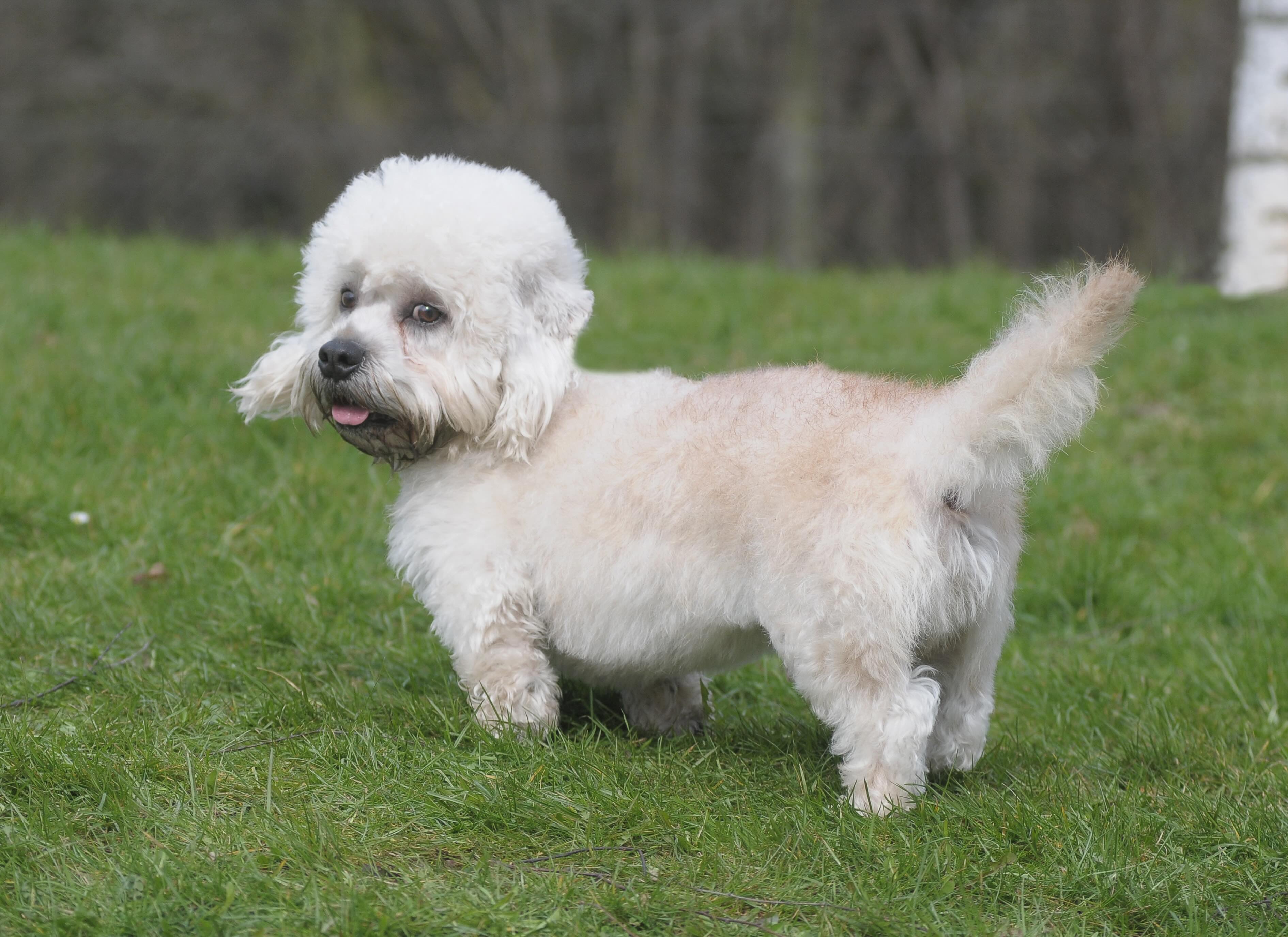Dandie Dinmont Terrier
Adobe Stock/dvr
Dandie Dinmont Terriers are a small breed with a friendly and intelligent personality. These terrier dogs date back to the 1700s, when they were developed as farm dogs along the border of England and Scotland. It was their job to hunt vermin for farmers.
Today’s Dandie Dinmonts still have the independent, hardworking spirit of their farm dog ancestors. They’re also considered extremely cute and are popular as show dogs.
“Look at a Dandie and the first thing you see are big eyes, big nose, big mouth,” says Sandra J. Wolfskill, president of the Dandie Dinmont Terrier Club of America (DDTCA).
Dandies are short and long. Adults stand 8–11 inches tall and are almost twice that in length. Most Dandies weigh 18–24 pounds fully grown.
Part of the Dandie Dinmont Terrier’s unique appearance is their curved back, which dips down at the shoulders. Their coat comes in two colors—mustard and pepper—and requires regular grooming to maintain their fluffy top knot and neat appearance.
Caring for a Dandie Dinmont Terrier
With good health and an easygoing temperament, Dandies are a mostly low-maintenance dog. They have moderate exercise requirements, and are happy with short daily walks or some time to run around a fenced yard. Dandie Dinmont Terriers do, however, require lots of time for grooming if you hope to maintain their classic look.
While many terriers have a reputation for being high-strung, active, and feisty, “the Dandies are more the gentlemen of the terrier world,” Wolfskill says.
“They're very funny, very charming,” says Sandra Pretari Hickson, DDTCA vice president.
These dogs are smart and do great with positive reinforcement training. They love to learn new tricks and try different activities—especially when they get attention for it.
“Anything that involves people or being fawned upon, they generally really like,” Hickson says.
Dandie Dinmont Terrier Health Issues

The Dandie Dinmont Terrier is a healthy dog breed with a long lifespan. Most Dandies live to be between 12–14 years old. They are not prone to many specific health issues, but there are a few things pet parents should look out for.
Glaucoma
Glaucoma is an eye disease caused by a painful increase of pressure behind the eyes, which can eventually lead to blindness in dogs. Signs of glaucoma include:
-
Dilated pupils
Wolfskill notes glaucoma is usually late onset in Dandie Dinmont Terriers. Blindness can happen suddenly, so pet parents must keep a lookout for symptoms and contact their vet immediately if any occur.
Lymphoma
Lymphoma is one of the most common cancers found in dogs. It can affect any organ but most often attacks the immune system.
The most telling symptom of lymphoma is enlarged lymph nodes. Pet parents should become familiar with what’s normal for their Dandie Dinmont Terrier, and look for other signs of lymphoma such as weight loss, increased thirst or urination, and loss of appetite.
Your vet will test for lymphoma with a biopsy or cytology. If the disease is detected, your dog will likely undergo chemotherapy, radiation, or surgery.
Cushing’s Disease
Some Dandie Dinmont Terriers are prone to Cushing’s disease, a condition where the adrenal glands overproduce certain hormones. This disease often develops slowly, and pet parents should watch for early signs such as:
-
Frequent urination
-
Excessive thirst
-
Decreased activity
Cushing’s disease requires oral medication, so speak with your vet to develop the best treatment plan for your Dandie.
What To Feed a Dandie Dinmont Terrier
Dandie Dinmont Terriers are not picky eaters, so pet parents should focus on choosing a high-quality dog food formulated for small dogs. The food must meet the nutritional standards set by the Association of American Feed Control Officials (AAFCO).
How To Feed a Dandie Dinmont Terrier
Most Dandies do well eating twice a day, with meals spaced 12 hours apart. Dandie Dinmont Terrier puppies may need to eat more frequently (up to four times every day) to prevent hypoglycemia.
Because Dandies are smart dogs, offering their food in a slow feeder bowl or food puzzle provides mental stimulation as they eat. This can also slow your dog’s eating and reduce the chances of stomach upset.
How Much Should You Feed a Dandie Dinmont Terrier?
How much you feed your Dandie depends on your dog’s weight, lifestyle, health, and age. Follow the recommended serving size on your dog’s food packaging, and review your feeding plan with your veterinarian.
It’s important not to overfeed a Dandie, Hickson says, because these dogs can put on weight easily. Obesity in dogs can lead to back pain and joint problems.
“It's not healthy for any dog to be heavy, but particularly a long-back dog,” Hickson says.
Nutritional Tips for Dandie Dinmont Terriers
Because this breed is healthy overall, dog supplements aren’t necessary unless recommended by your vet. However, your dog may benefit from certain joint supplements or fish oil if your veterinarian makes the recommendation.
Behavior and Training Tips for Dandie Dinmont Terriers
Dandie Dinmont Terrier Personality and Temperament

Dandie Dinmont Terriers are personable, friendly dogs that love people. This breed enjoys being trusted with a job, but is also happy to relax and nap away the afternoon.
“They make great family pets because you can take them anywhere,” Hickson says. “They love everybody, but they're also very happy to just stay home and cuddle on the couch with you.”
Most Dandies are great with children and tend to get along well with other dogs. However, their history as hunters may make them a tricky match for smaller pets.
“They do have a prey drive because their job was to go dispatch things with fur,” Wolfskill says.
Pet parents should be cautious of how they introduce different animals into the home. Other dogs and adult cats are generally seen as peers by the Dandie. But for a Dandie to understand a kitten as a peer instead of prey, it’s best if the animals are raised together.
“You wouldn't want to bring a kitten in ... without being very careful about how you introduced it,” Wolfskill says. “Because if something runs, their tendency is to run after it.”
Dandie Dinmont Terrier Behavior
Dandie Dinmonts are mostly well behaved and calm companions. As farm dogs, these terriers learned to stay alert of their environment, Wolfskill says, so they will occasionally bark to get your attention.
“They're telling you something happened that you need to know about,” she says.
These dogs are generally soft-spoken and only bark when they hear unexpected noises. Otherwise, Dandies are happy to lie around and relax in between meals and play time.
Dandie Dinmont Terrier Training
Many Dandie Dinmonts are show dogs and love to learn new tricks to please their audience.
“They are, for the most part, very food-motivated,” Hickson says. “So if there's a snack in it for them, you can get them to do just about anything.”
To ensure success in training, Hickson says consistency and positive reinforcement are key. Although they are incredibly cute, they’re also terriers that were bred to be independent. Hickson says it’s essential to maintain their attention when training.
Begin socializing your puppy as soon as you bring your new Dandie home. This early exposure to new situations helps them grow into confident, friendly, and polite adults.
Fun Activities for Dandie Dinmont Terriers
-
Scent work
-
Fetch
Dandie Dinmont Terrier Grooming Guide

Grooming a Dandie Dinmont can be a time-consuming task, especially for pet parents who want to maintain the classic Dandie show dog look. Although the dogs barely shed, their unique coat requires special care for traditional upkeep.
Pet parents who don’t plan on showing their Dandie Dinmont Terrier can instead opt for a visit to the regular groomer every couple of months.
Skin Care
Brush your Dandie every other day to avoid matting, which can cause skin infections and other issues. During this time, pet parents can also check for sores, scratches, or signs of fleas or ticks. Contact your vet if you notice any changes in your dog’s skin.
Coat Care
The Dandie’s coat has two parts, Wolfskill says: the soft coat and the “pencil coat.”
-
The soft coat is a shorter coat found on their top knot, legs, and belly. It gets trimmed with scissors.
-
The pencil coat is made of a stiffer, longer coat that looks like fine pencil marks. Traditionally, this part of the coat is hand-stripped, a process during which excess hair is removed by hand to maintain a tidy, natural look.
“That's what gives it a crispness that is characteristic of the breed,” Wolfskill says.
Maintaining the traditional Dandie coat requires a couple of hours each week. But if the traditional Dandie Dinmont coat isn’t important to you, taking a more laid-back approach to grooming is also an option.
“If you're not inclined or you can't find somebody to [hand-strip] for you, then certainly clippering them, and taking them to a groomer who can follow the pattern of a Dandie, is sufficient,” Hickson says.
Eye Care
With large eyes and lots of fluffy hair on their top knot, Dandies are liable to get hair in their eyes. Keep up with grooming, and check your dog’s eyes regularly for signs of glaucoma.
Ear Care
Like all breeds, Dandies need their ears checked regularly for signs of an ear infection (redness, odor, discharge, etc.). If your dog’s ears look dirty, clean them with a gentle vet-approved solution.
Considerations for Pet Parents
The Dandie Dinmont Terrier is a healthy, personable breed that lives well in apartments and houses alike. They’re food-motivated and eager to learn new tricks—as long as they get a dog treat for it. Make sure they get a little active time each day, and they’ll be happy to lounge around and enjoy their family’s company.
Traditionally, these dogs require a few hours of grooming per week.
Dandie Dinmont Terrier FAQs
Are Dandie Dinmont Terriers rare?
Yes, Dandie Dinmont Terriers are considered a rare breed in the U.S. Litters are three to five puppies on average, says Wolfskill, and with a decrease in breeders it can be hard to find one. However, organizations like DDTCA offer resources to help people connect with breeders.
How much does a Dandie Dinmont Terrier cost?
Expect to spend $1,500–$2,500 on a Dandie Dinmont Terrier.
Can a Dandie Dinmont Terrier be left alone?
Dandies are OK to be left alone for up to four or five hours at a time, according to Wolfskill. Dog parents who will be gone for more than half a day should consider hiring a dog walker or pet sitter to spend time with this friendly breed.
